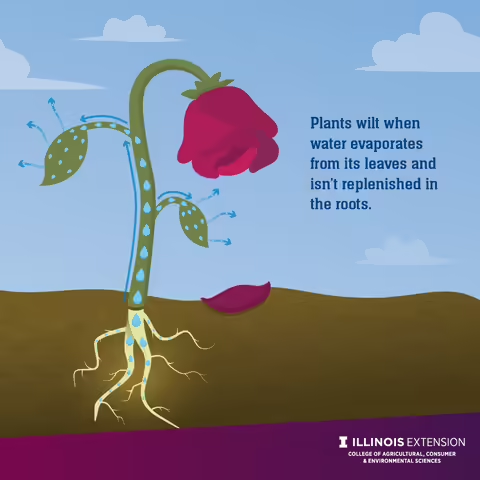URBANA, Ill. – All plants need water. When natural rainfall does not provide enough, plants suffer. University of Illinois Extension provides homeowners with ways to keep gardens healthy and thriving through periods of drought.
"When areas don't receive rain for extended periods, the water content of the soil is so reduced, plant material can no longer extract sufficient water for normal life processes," says Martha Smith, Illinois Extension horticulture educator. "Whereas large plants, such as trees, have extensive root systems capable of reaching deep water sources, perennials and annuals don’t and must use only water immediately available to them. While some plants are able to tolerate dry conditions, others die quickly."
Wilting is the first visible sign of drought stress. Perennials and annuals are herbaceous ornamentals and do not have a woody structure to support them.
"It's the water pressure within the stem that holds a herbaceous plant upright,"Smith says. "Water is pulled into the roots as it evaporates from the leaf's surface, forming a water column."
Water travels up the stem and evaporates through the foliage. If foliage evaporation exceeds the root’s ability to pull in water due to drought, the water column breaks and wilting results.
"Think of it as a tug-of war between available soil water and evaporation through the foliage," Smith says. "If additional water is supplied within a reasonable amount of time, most perennials and annuals will respond and continue normal growth. If drought conditions continue, plants wilt beyond their ability to recover."
Perennials that suffer through one drought may not have enough stored food to help them through a second drought year, resulting in smaller or fewer flowers. If dry conditions and high temperatures continue over several seasons, these plants may be lost, Smith says.
Illinois Extension offers suggestions for growing plants during droughts.
- Prepare soil. Add compost and aged manure products to tight clay and sandy soil prior to planting to give soil water something to adhere to. During drought, clay soils become hard and difficult to re-wet, causing water to run off before it can penetrate. Compost and aged manure improve absorption.
- Add mulch. Adding a 2- to 3-inch layer of mulch helps soil retain moisture.
- Group plants according to their watering needs. Artemesia, Coreopsis, and Sedum species are all tolerant of dry, sunny locations. Astilbe species, Trollius species, and ferns require more moisture.
- Consider planting time. Perennials planted in late spring or early summer may not have time to establish a sufficient root system needed for hot weather, so plant perennials in early spring or fall.
- Remove moisture competitors. Weeds and turf also need water to survive, so eliminating these will allow more moisture for ornamental plants.
- Cut back on fertilizing. Adding nutrients promotes plant growth and increases a plant's need for water.
- Supply additional water. Herbaceous ornamentals benefit from 1 inch of water every seven to 10 days during the growing season.
SOURCE: Martha Smith, Horticulture Educator, Illinois Extension
ABOUT EXTENSION: Illinois Extension leads public outreach for the University of Illinois by translating research into action plans that allow Illinois families, businesses, and communities to solve problems, make informed decisions, and adapt to changes and opportunities.
